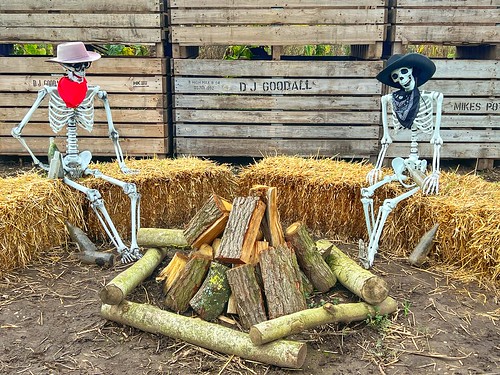Culture Re-View: Happy Halloween! Do you know Europe’s scariest mythical creatures?
Happy Halloween #HappyHalloween

Happy Halloween, one and all.
To celebrate that most ghoulish of all the holidays, Euronews Culture has taken a trip around Europe to explore some of the lesser-known mythical creatures in European folklore – as well as their influence in popular culture.
Are you brave enough?
The Green Man (UK)
The Green Man – Canva
Wander around anywhere in the countryside of the UK for long enough and you might spot it. Hiding in plain sight, his face is carved into churches, he lurks in the corners of paintings, and his name even lives on in the names of pubs and a music festival. While he’s a mainstay of Church art across the country, the theory is that the Green Man’s origin is pre-Christian. A pagan legendary figure that has been so persistent throughout the ages that he survived the introduction of Christianity to the UK by the Romans.
Click here to find out why you should fear The Green Man.
Baba Yaga (Eastern Europe)
Baba Yaga – Rima Staines
In Eastern European folklore, Baba Yaga (or Baba Yaga Bony Legs / ‘Baba Jaga’ in Polish) is a voracious and deformed crone who kidnaps her victims before cooking and eating them. Usually children. Something about the flesh being more tender. The supernatural entity usually lives in a house that spins continually on birds’ legs. Oh, and if that wasn’t sinister or batshit crazy enough, she sometimes joins Death on his travels, helping him to devour newly released souls. As you do.
Click here to find out more about the terrifying inspiration for all the forest crones, wicked witches or evil godmothers you’ll have come across in childrens’ stories and films.
Trolls (Norway)
A scene from the film Trollhuner – Magnet Releasing
Trolls are one of the most ubiquitous monsters that show up in fantasy tales. They’re in the Lord of the Rings, Dungeons and Dragons and Disney’s Frozen, to name but a few. But the origin of the creature can be found Old Norse mythology. Look through almost any old Norwegian fairy tale and a troll isn’t far away.
Click here for more on the sizeable nightmare fuel.
The Golem (Czechia)
Still from the film Der Golem (1920) – UFA
We now move to Czechia and the Golem. The figure of the Golem originates from Jewish folklore. It is an animated anthropomorphic being created from inanimate matter – usually dust, clay or mud. The monster is brought to life by ritual incantations and a sequence of Hebrew letters. The first practical instructions on creating a Golem can be found in the mystical text of Sefer Yetzrah, the Book of Creation, Kabbalah’s oldest text written by Abraham who transmitted it to his son Isaac. Originally, the creation of a Golem was a way for medieval Jewish mystics to come closer to God. However, prophets have warned people against the belief that man could compete with God’s creative powers, making the creation of the artificial man simultaneously a way of honouring one’s beliefs in a higher power and the hubristic betrayal of the unwise who believe they can break the code of creation’s secrets.
Check out more on this fascinating figure.
El Coco (Portugal)
Many Cocos – Canva
Off to Portugal we go. Despite what you may think, El Coco isn’t just the Spanish name for a hot chocolate. It’s actually the greatest source of horror for many children in Spanish and Portuguese speaking countries. El Coco is basically the Bogeyman. It’s the tale that haunts the edges of every nervous child’s room when it’s plunged into darkness at bedtime. The origin of the myth is believed to come from Northern Portugal and Galicia. Known as the Coco or the Cucuy, the word is derived from the word for “coconut” and refers to the head or skull of a person.
Find out more here.
The Banshee (Ireland)
The Banshee – Epica Simone
A ghoulish harbinger of doom or a friendly warning from a departed loved one? The banshee is integral to Irish folklore and a strong part of Gaelic tradition. These monsters come in different shapes and sizes, but their mystical powers always stem from the unique sounds they make.
Block your ears and click here if you want to know more.
Wolpertinger (Germany)
Taxidermy version of the dreaded Wolpertinger – chiswickauctions
Odd one, this one… Germany gives us the Wolpertinger. This is not one of the most frightening mythical creatures on our list, especially compared with the Baba Yaga or trolls. Picture a small mammal resembling a rabbit with antlers, wings and webbed feet who lives in the alpine forests of Bavaria and Baden-Württemberg. Yep, that’s it.
But there’s more to the bunny hybrid than meets the eye…
Ogres (France)
Gustave Doré: Illustration for Le Petit Poucet, 1862 – Public Domain
For our final entry takes us to France and its legendary ogres. The word ogre is originally of French descent and derives from the Etruscan god of the underworld and punisher of oathbreakers, Orcus. Orcus is usually depicted as a bearded giant who feeds on the flesh of humans. Charming…
Here’s everything you need to know about the large and frankly, quite ugly beasts.
Have a great Halloween and stay tuned to Euronews Culture for the ideal Halloween playlist.